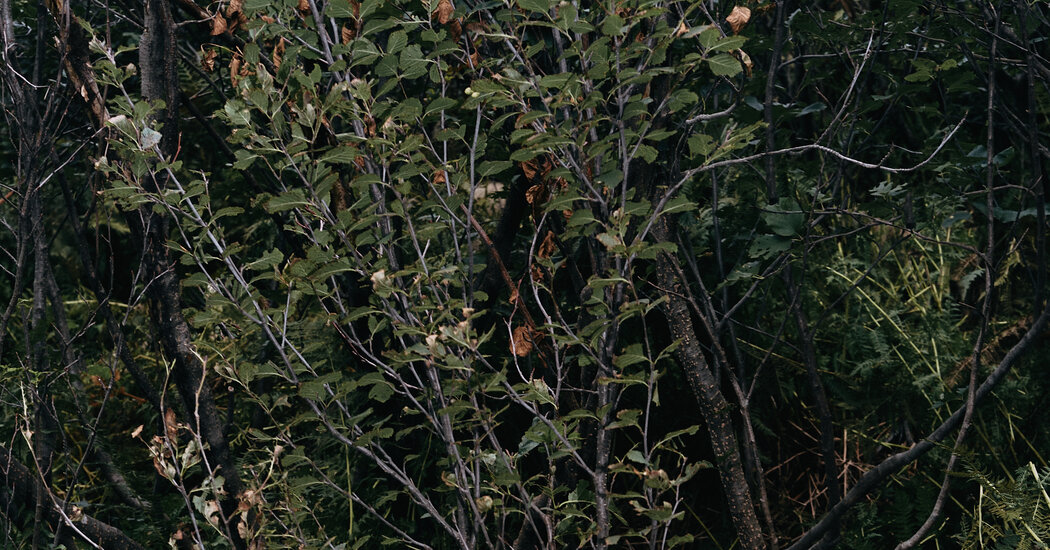We’ve taken dogs and cats into our homes, trained hawks to hunt for us and taught pigeons to deliver our letters.
Our relationship with sheep, though, is more of a symbiosis.
For centuries, we have relied on sheep’s wool for clothing and blankets, and they relied on us for shearing. Now, sheep can’t molt without human help, though we’re using little of their wool. Because consumers today favor softer and less expensive synthetic fibers, an enormous output of raw wool — estimated by researchers at more than 317,000 tons worldwide — goes to waste each year.
This paradox of mutual reliance is at the center of the exhibition, “Formafantasma — Oltre Terra,” at the Stedelijk Museum Amsterdam, from Feb. 15 through July 13. The show, by the design studio Formafantasma, is billed as examining the “co-evolution” of sheep and humans across some 11,000 years and contains thoughts about how we might improve the relationship.
Formafantasma, founded by Andrea Trimarchi and Simone Farresin and based in Milan and Rotterdam, the Netherlands, creates products for international companies such as Lexus, Tiffany and Prada, as well as exhibitions for museums and galleries. Its unique design objects have been acquired by arts institutions including the Museum of Modern Art in New York and the Victoria and Albert Museum in London.
“For me they are among the most important designers of their generation,” said Hans Ulrich Obrist, the artistic director of Serpentine, a London-based art institute which hosted a 2022 exhibition by Formafantasma, that focused on a different raw material: wood.
“They have this impressive multidimensionality,” Obrist added. “They are amazing researchers and they are environmentalists, and at the same time they are creating these extraordinary objects.”
Working with a small team of designers, Trimarchi and Farresin say they begin each project by conducting two or three years of research into the materials they plan to use, a process they call “investigative design.”
To better understand wool for “Oltre Terra,” the team began by interviewing experts including farmers, shepherds, biologists and anthropologists, as well as philosophers and activists.
This approach stretched the definition of design to include a process of “co-creation” between species, said Amanda Pinaith, a Stedelijk curator.
“We as humans have designed this relationship with sheep,” Pinaith said. “Over hundreds and hundreds of years, tame sheep have developed through human design,” she added, “so that it would become a wool-producing machine with ears and eyes, instead of an animal.”
Take Shrek, for example, a merino sheep in New Zealand who became a global celebrity in 2005. After escaping his flock, he lived alone for six years until he emerged, weighed down under 60 pounds of fleece. His televised sheering was a national event; he met New Zealand’s then-prime minister, Helen Clark; made charity appearances; and was featured in children’s books, before he died at age 16 in 2011.
Shrek’s reliance on human intervention reflects one small way in which we have, over centuries, “designed” sheep rather poorly, according to Formafantasma. The Stedelijk exhibition begins with a replica of Shrek, whose story is a useful metaphor for how social design shapes our environment and how we think about nature.
Those relationships are explored in a variety of displays. For example, visitors are invited to sit on a carpet made using 12 types of wool to watch a short video, “Tactile Afferents,” that explores the nature of physical contact between humans and sheep, created by the artist Joanna Piotrowska.
Photographs of prizewinning Australian merino sheep with rippling fleeces are shown alongside images of the damage that deforestation and overgrazing by the sheep farming industry have caused to Australia’s soil and plant life.
The exhibition also explores recent efforts to “redesign” sheep to produce new breeds that can shed their wool without shearing.
Formafantasma interviewed Tim White, a British sheep breeder who is attempting to crossbreed his sheep with ewes that grow hair instead of wool. In the catalog, White explains that farmers could once pay rent for a full year from wool revenue alone, especially in the early 20th century, when wool was used for army uniforms. Now, however, “the price of wool doesn’t even cover the costs associated with sheering,” he is quoted as saying.
The installation includes information about the crossbreeding efforts by White and others in a large-scale diorama built around an aluminum lattice, on which a range of elements is displayed: videos, taxidermy, archival photographs and objects, like sheep sheering devices from across the ages.
Visitors learn, for example, that the wool we tend to use today is merino, produced in only a few places in the world, primarily Australia and New Zealand. Fleece from most ordinary sheep everywhere else has become waste material, which is usually dumped or burned.
Formafantasma plans to use its accumulated knowledge to find new ways to use excess wool for sustainable design. The studio is already working with an Italian furniture company, Tacchini, to manufacture sofas using surplus wool for the interiors, as a replacement for industrial foam, and with the American textile company, Maharam, to develop a second project, details of which Formafantasma said it could not yet disclose.
Obrist, the Serpentine’s art director, said that the strength of Formafantasma’s approach was that its research-based method also ends up transforming the ways that real-world products are made.
“At the moment, we have a lot of design is really strong on research but that doesn’t produce any objects, and then we have a lot of wonderful design that produces objects, but doesn’t have any research,” he said.
“Very few people do both,” Obrist said, “and I think that’s a big achievement.”
Formafantasma — Oltre Terra
Feb. 15 through July 13, at the Stedelijk Museum Amsterdam; stedelijk.nl.


